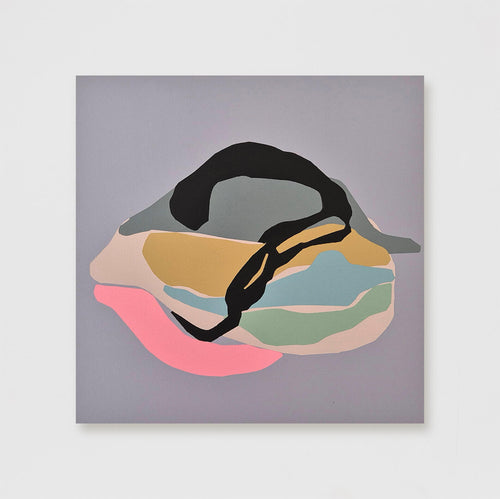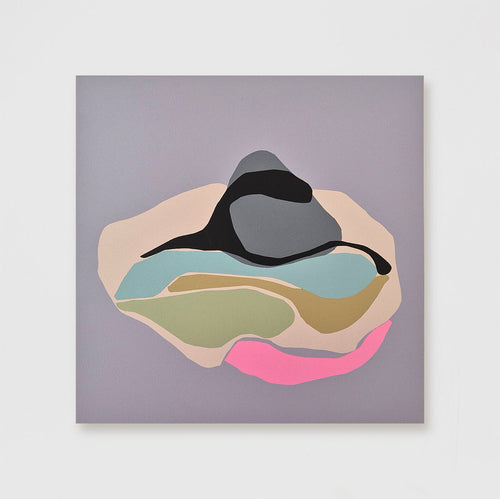Gisele Camargo's artistic journey has been, since the beginning, a journey through the landscape that includes more strongly pictorial works, such as the Erosões and Brutos series, and also the series that precede Paisagem-semente, an exhibition that is part of a trilogy that includes Tabuleiro and Construção.
Seed-landscape is an unfolding of the previous processes and, here, the artist deepens her relationship with color, the result of the vastness of the landscape that revealed itself to her in Serra do Cipó. In this place in the cerrado of Minas Gerais – with mountains, erosions and the unique presence of nocturnal mysteries, rocks, plants and various natural elements in constant change – the artist from Rio de Janeiro came into contact with forces that were previously unknown and discovered a pulse that opened space for an inventory of universes and species that explode, branching out into an infinite cataloguing, generating its own visual syntax with a chromatic vibration that encompasses tones and nuances of hills, plants, rocks and rocky landscapes, the sky and the undergrowth sheltered in the logic of detail.
Composed of ten sections, the exhibition is the synthesis of a territory that unites the possible and the impossible. The sections have their own palette and theme and are interconnected by elements extracted from the artist's perspective. Gisele Camargo addresses the unknown and makes present things from the margins, from the presence and exile of everything. The eleventh section traverses the scene in an installation-like manner and helps to mix the classificatory categories: they are moons, a synthesis of what vibrates in the play of color and palettes. As a nocturnal enigma, the moon can orbit other sections and elements or it can be, in itself, an epiphanic section that reveals the cosmic force of a painting attentive to the mysteries of the sky, which captures the trail of spaceships, satellites and planets. The moon is also the pure presence of otherness that affects and changes us, as it reveals the change of things in the world.
The astonishment that the artist preserves is also an ethic that intoxicates the boundaries of what is close and what lives in the confines of the gaze between the human and the non-human – nature, history, matter and the immaterial. In the essay Sensitive Life, Emanuele Coccia investigates sensitivity, through a new understanding of the categories of the human. In his writings, the Italian philosopher proposes that we look at the world, allow ourselves to be touched by vegetable, mineral and animal thoughts, and encounter a kind of “philosophy of mixture”.
Gisele Camargo forges Paisagem-semente from the same point, in contact with a sensitivity arising from a field in which the human also exists and lives as an image. Gathering colors, textures, nuances and thicknesses from nature, the artist constructs a visual world that does not use painting as a direct instrument for representing reality, but rather transfigures reality in form and content, sheltering, in the same gesture and in the same gaze, the ethical and aesthetic dimensions. They are fragments of worlds that form a moving archive with overlapping layers of time that, erasing images and rewriting the landscape, allow the field of visibility to flow, in an amplitude that reveals endless relationships between the sky and the earth, capturing fragments and deviations guided by their deep relationship with color.
Goethe carried out his first chromatic investigations in front of the window, as visual experimentation. Her book Doctrine of Colors presents the understanding of color as a language and opens space for analysis of chromatic phenomena. For Gisele Camargo, color is also an alchemical and magical phenomenon, which occurs in the face of the surroundings and its “window to the horizon”. In her work, colors and shapes live under a continuous process of mutation in which chromatic properties are forms of coexistence. The world is embodied in the landscape through color, which accesses absence and presence. As Matisse taught, color is always a relationship.
Seed-landscape is the germination of an aesthetic and thought act, a sensitive experience that shelters the relationship between the visible and the invisible and invites us to look at the undulations of what we see, at the spots that appear as an enigma in the images. The landscape is here a perceptive experience that articulates the human being and the world, a portal and a cutout of space-time opened by the horizon. Gisele collects the germination and makes nature represented by the landscape erases the tradition of seeing and visibility. It is about transversing the world through the magnetization of color and the immanence and transcendence that, here, operate together.
What is decanted in each nucleus reinstates and challenges the paradigm of vision, by seeking to touch the untouchable in the image, to represent the infigurable, reaching the cosmos, through the detail and richness of the fragment. The artist said that “one day I was drawing the mountain and the spots inside the mountain caught my attention, as they change all the time. I observed the clouds and lights and shadows falling on the mountain and I wanted to paint that. That is how this series of works began”.
Origin and destiny, mystery, alchemy and other cosmogonies open up permeated by moons, colors, traces of the visible field that touch the invisible, just like what sparkles in the poetry of Herberto Helder: “The full moon hangs solitarily over a house on the riverbank. The night water flows beneath the bridge. The gold spilled into the river is alive. My blanket shines brighter than precious silk. The silent mountains without anyone. The spotless circle – the moon spins among the constellations.”
Bianca Coutinho Dias




































